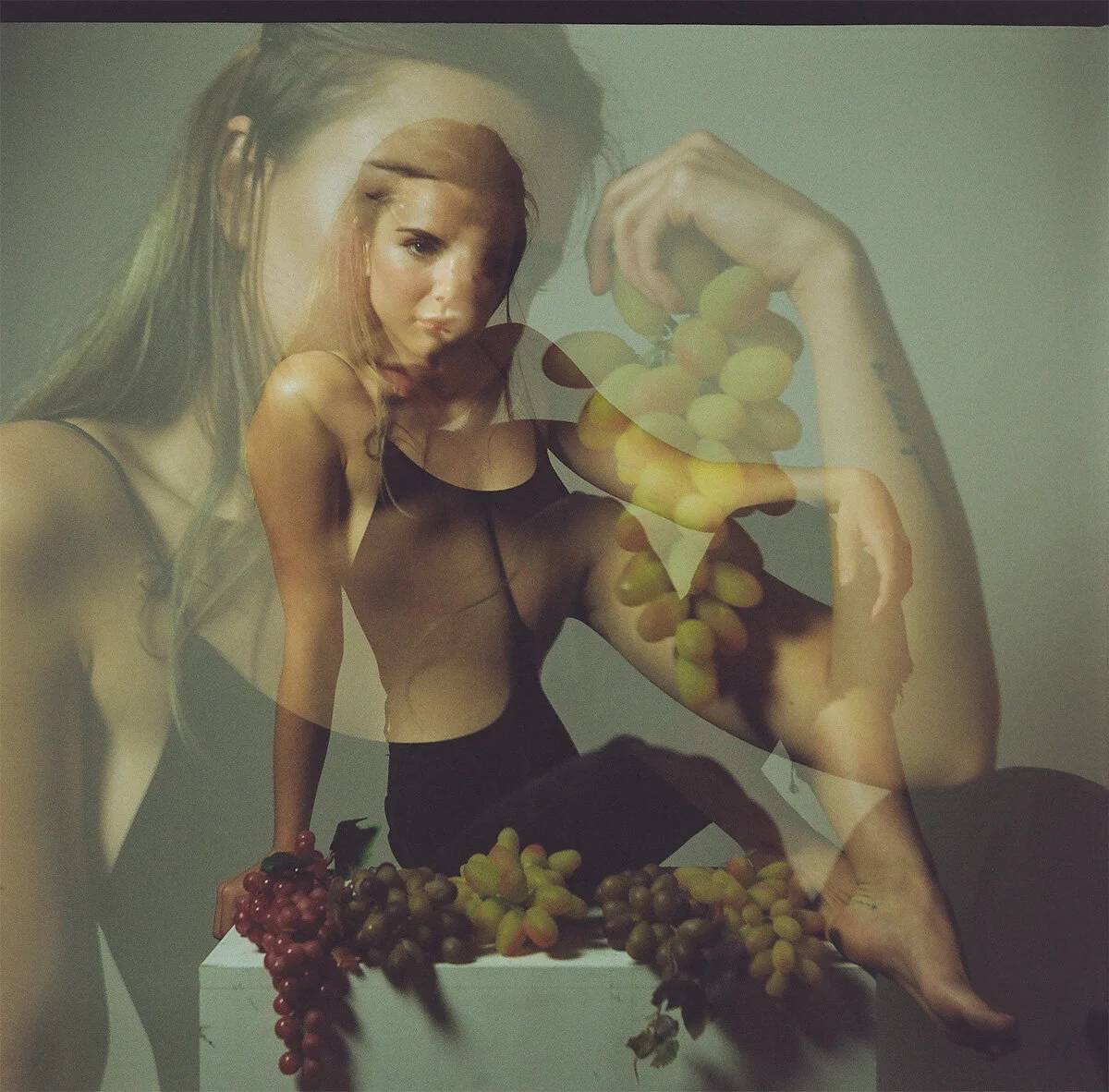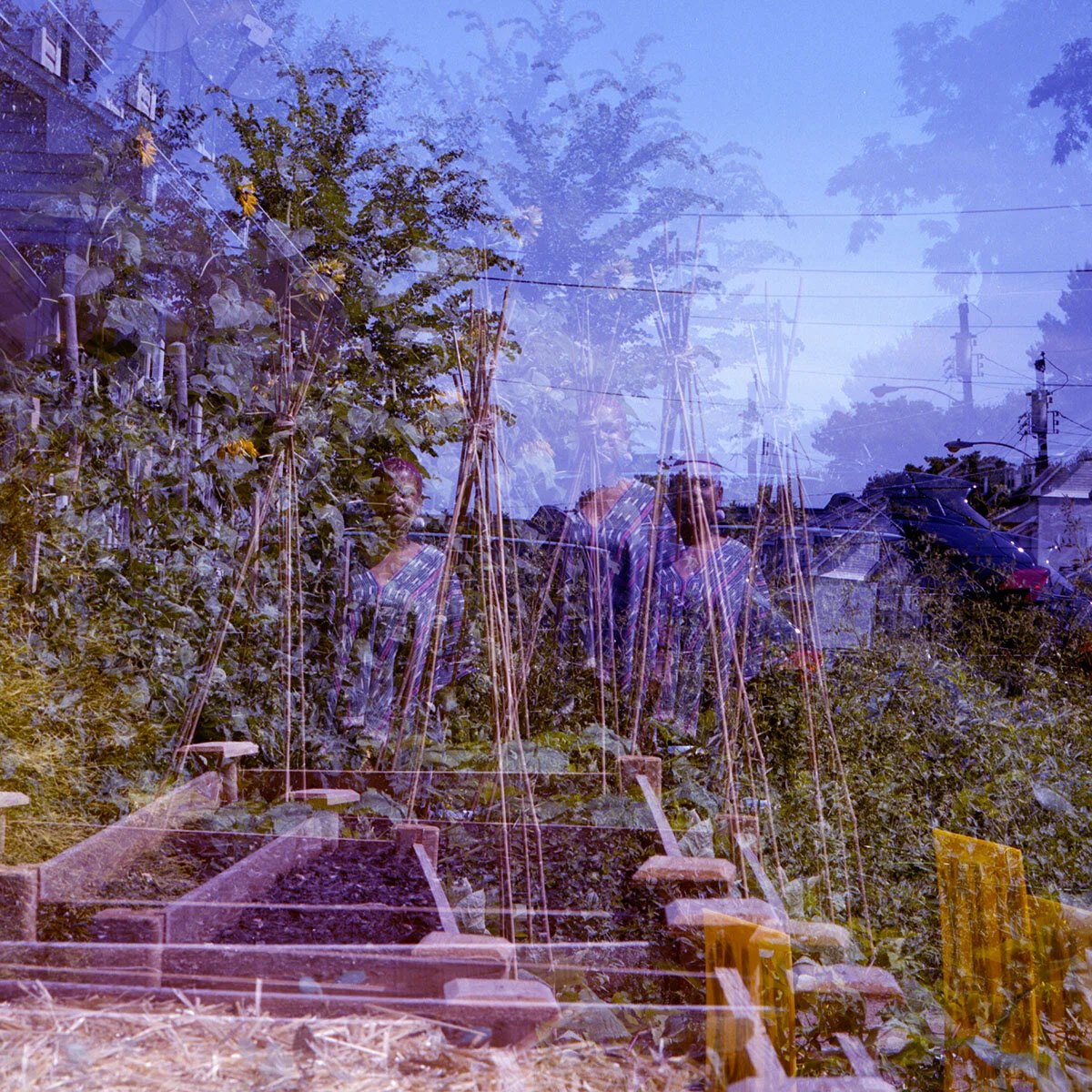© Tiffany Sutton
Tiffany Sutton's multiple exposure portraits show the complexity of visualizing identity.
When photographing with film, multiple exposures are often accidents or visual gimmicks. The film failed to advance on a roll, abstracting a few images onto a single frame. Looks cool. Can it go deeper? Absolutely.
Tiffany Sutton’s multiple exposures consider the limitations, yet endless possibilities of meaning and representation in photographic portraiture. A moment to slow down and carefully examine the person being photographed as more than just a visual specimen. To examine the full scope of an individual - their culture, gender, influences, joys, and struggles. To look with infinite layers of psychological space. Perhaps a light-sensitive channeling of futurism and abstract expressionism. An opportunity, as Sutton describes, “to catch every moment in the subject’s life.”
I spoke with Sutton – whose work we recently included in Humble’s “Two Way Lens: Portraits As Empathy” exhibition - to learn more about her process and ideas on portraiture’s wide potential.
Jon Feinstein in conversation with Tiffany Sutton
© Tiffany Sutton
Jon Feinstein: How did you get into making double exposure portraits?
Tiffany Sutton: I have been fascinated with double exposure since college when I started using the school’s Hasselblad. This camera allows the maker to shoot an image, remove the back of the camera where the film is, advance the shutter, and once reattached shoot on the same negative frame. From then to now I’ve been playing with the endless possibilities of meaning in the making of multiple exposures. What some photographers might see as a mistake I see as potential to tell a more complex story.
I revisited the process with my previous series Girls with Fruit Vol II. In the series, the multiple exposures represented the multitudes of symbolism in nature and womanhood. For this series, the nonclassical portraits spoke directly to the multiple classical meanings art history has placed on both women and fruit. Neither is simply seen as is, there is always another perception, another opportunity to force a meaning on something binary.
© Tiffany Sutton
Feinstein: What do you think this process communicates vs your "straight” portraits? What metaphors are you trying to communicate?
Sutton: The first Black woman I saw in a painting was Manet’s Olympia and she was a servant. It seems that any Black character, man or woman, in art was an anthropical study or subjects were ignored and seen as not important or have a meaningful impact, and like so many Black artists, I wanted to change the idea of the Black body in art.
In my current work, multiple exposures speak to the complexities of Black women in society. What I am attempting to communicate is the same meaning a Black woman attempts to communicate with fashion, hair, and nails, we are ourselves not what is projected on us by society using multiples, the viewer is challenged to look more deeply. In exhibitions, there are single exposure images in which the viewer's eye can rest. It is also an opportunity to see the Black body without distraction.
© Tiffany Sutton
Feinstein: Why do you shoot film exclusively? Why is it important to your work and ideas?
Sutton: I shoot film exclusively because it feels the most natural way of making images that give value to my subjects. Believing that my subjects have value is important to the work because I want the viewer to see that value. Film photography is very expensive and time-consuming knowing that I take my time to photograph Black women aids the thesis of the work. The image becomes an imprint of their visibility, their alterity gone. Plus, it is fun.
Feinstein: On the surface, there's a "chance"-iness to the images being multiple exposures. How important is this concept of chance important to your work?
Sutton: The use of multiple exposures isn’t primarily about “chance”. The surprise when the negatives are developed aid the way I want the viewer to stop and investigate the person in the image.
Feinstein: I'm drawn to the following words in your statement. Can you expand on this? "My work examines divine love within Black female relationships while redefining social racial landscapes."
Sutton: I’m inspired by the author bell hooks and her book All is Love. This book of essays talks about how and where she found love in her daily life. When I discovered her work it was like meeting a new friend, her work spoke to me because I’ve been searching for love in myself and within other women.
While photographing a subject, I think about how similar we are to each other. It explains the connection we have even when it is the first time we’re meeting and working together. That divine love is what binds Black women together.
I like to think of the first woman being a Black woman and how throughout our DNA is this one figure that grounds us all, that’s divine. This divine love from a primordial Black mother is in everyone and when you can see that you change how races react to each other and how Black women embrace each other.
© Tiffany Sutton
Feinstein: Connected to that, another thing that strikes me about your work is the focus on Black joy, which you reference and reflect in your statement as well. Can you talk about your thoughts on this as it applies to your work and how you represent and celebrate Black women?
Sutton: As a Black woman I can tell you that it can be hard to be joyful when large populations, laws, and media say you are less than everyone else. As a group, we don’t get a lot of respect in social movements like the Feminist and the Black Power Movements. In fact, we are never meaningfully represented in either movement and without Black women, these movements don't carry the emotional weight that is needed to change opinions.
So there is a ton of baggage Black women carry and most of it is not ours, yet we bring it along with us; it's exhausting. So when I ask a Black woman if I can photograph her, I bend over backward to make sure she is comfortable, feeling beautiful, and feeling the joy I’m trying to bring to her. During our shoots, we laugh, talk about ourselves, and leave the outside world outside. Our shoot becomes a self-care, self-love moment. That energy is mirrored in the photographs.
© Tiffany Sutton
Feinstein: Your work, as you describe, and is clear from looking at it, references different ways of looking in the history of portraiture - in art historical narrative painting, in snapshots, and in documentary photography. It's fascinating for me to see these come together, especially through multiple exposures. It feels like you're playing with literal and metaphorical thinking at once.
Sutton: It has been a long term goal to create an image so arresting that the viewer knows who the model is without ever knowing the model. I think of the Portrait of Madame X by John Singer Sargent and how he painted her in profile, looking away from the viewer. He created curiosity in the viewer; we want to know more about her but it remains a mystery. Throughout my Black Body Radiation series, I’m striving to create the same mystery. Sargent’s painted women are important and that’s all we know; the Black women in my work are important too.
© Tiffany Sutton
Feinstein: What’s your relationship to the women in these photos? Who are they in your life and how are you selecting them to photograph?
Sutton: St.Louis is a large city, small town, which means everyone is six degrees of separation from the same neighborhood; this is where I meet these women. I haven’t had many Black female friends since adolescence so I made it a goal to build friendships with Black women the way I’ve always made friends; by asking if I could take a picture of them.
When I seek another Black woman to photograph, I advertise on Instagram and ask previous collaborators for referrals, so I only know the names of the women I plan to photograph. I love that! I don’t have specifics; the woman doesn’t need to be similar to me in any meaningful way. They just have to trust that I’ll treat them right as they want to be treated with friendly respect.
A benefit of the pandemic, I was able to pay my subjects a modeling fee for their time. This was important to me as it makes us collaborators and shows that I value them. It's great to be asked to model. It's better to get paid to model. Once the shoot is over we have become friends and work together again.








